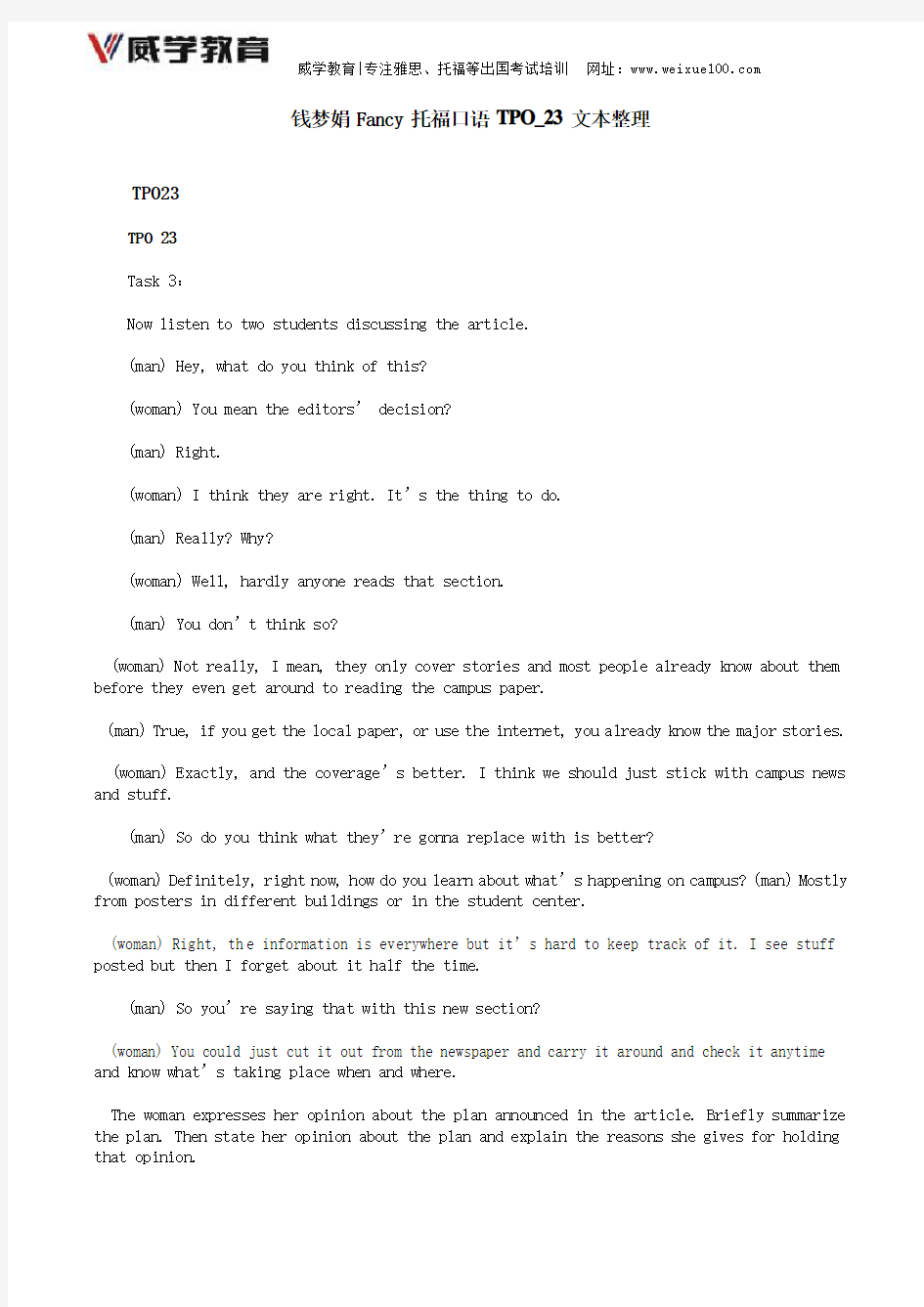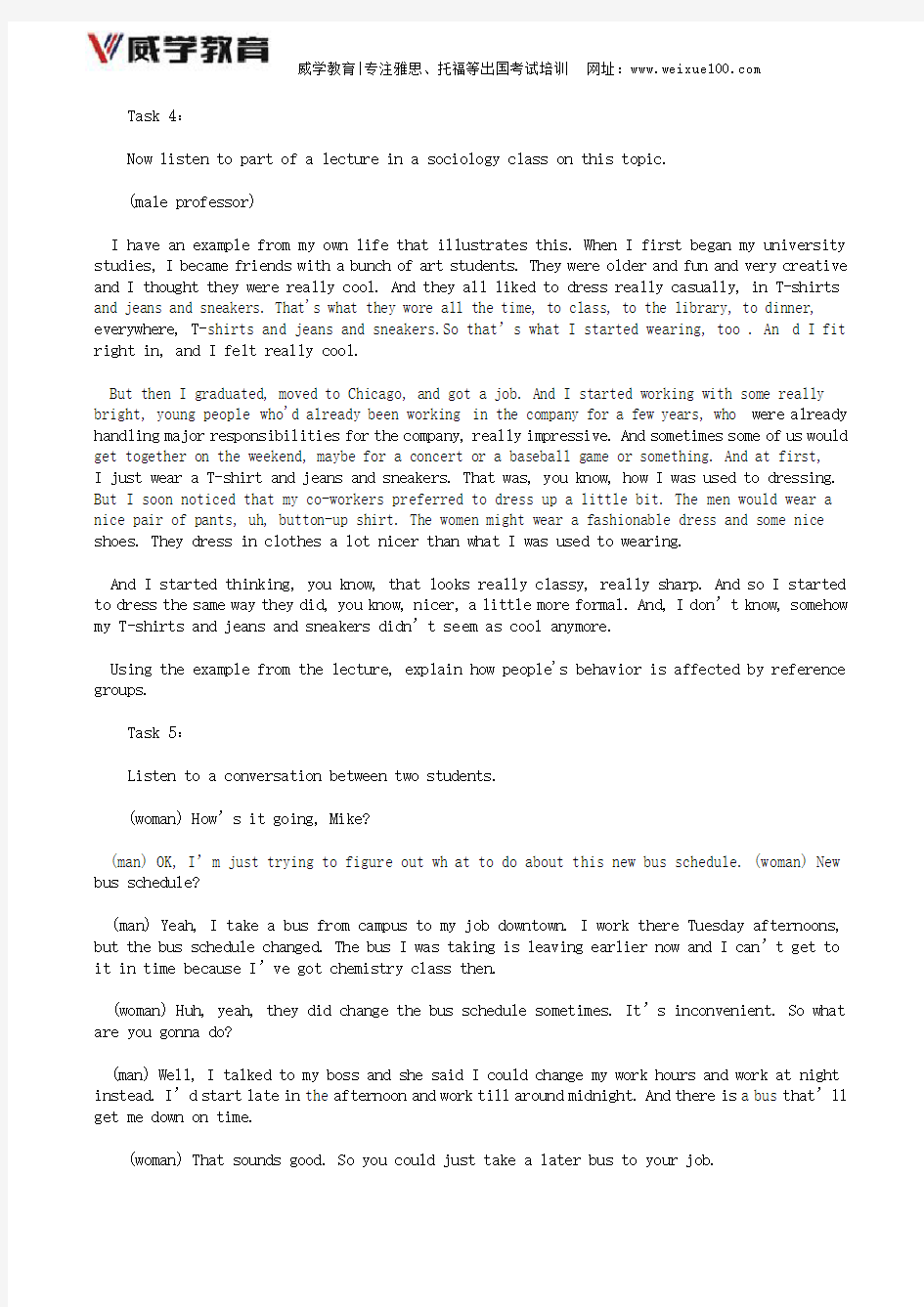【威学教育】钱梦娟Fancy托福口语TPO-23听力文本


TPO23
TPO 23
Task 3:
Now listen to two students discussing the article.
(man) Hey, what do you think of this?
(woman) You mean the editors’ decision?
(man) Right.
(woman) I think they are right. It’s the thing to do.
(man) Really? Why?
(woman) Well, hardly anyone reads that section.
(man) You don’t think so?
(woman) Not really, I mean, they only cover stories and most people already know about them before they even get around to reading the campus paper.
(man) True, if you get the local paper, or use the internet, you already know the major stories.
(woman) Exactly, and the coverage’s better. I think we should just stick with campus news and stuff.
(man) So do you think what they’re gonna replace with is better?
(woman) Definitely, right now, how do you learn about what’s happening on campus? (man) Mostly from posters in different buildings or in the student center.
(woman) Right, th e information is everywhere but it’s hard to keep track of it. I see stuff posted but then I forget about it half the time.
(man) So you’re saying that with this new section?
(woman) You could just cut it out from the newspaper and carry it around and check it anytime and know what’s taking place when and where.
The woman expresses her opinion about the plan announced in the article. Briefly summarize the plan. Then state her opinion about the plan and explain the reasons she gives for holding that opinion.
Task 4:
Now listen to part of a lecture in a sociology class on this topic.
(male professor)
I have an example from my own life that illustrates this. When I first began my university studies, I became friends with a bunch of art students. They were older and fun and very creative and I thought they were really cool. And they all liked to dress really casually, in T-shirts and jeans and sneakers. That's what they wore all the time, to class, to the library, to dinner, everywhere, T-shirts and jeans and sneakers.So that’s what I started wearing, too . An d I fit right in, and I felt really cool.
But then I graduated, moved to Chicago, and got a job. And I started working with some really bright, young people who'd already been working in the company for a few years, who were already handling major responsibilities for the company, really impressive. And sometimes some of us would get together on the weekend, maybe for a concert or a baseball game or something. And at first, I just wear a T-shirt and jeans and sneakers. That was, you know, how I was used to dressing. But I soon noticed that my co-workers preferred to dress up a little bit. The men would wear a nice pair of pants, uh, button-up shirt. The women might wear a fashionable dress and some nice shoes. They dress in clothes a lot nicer than what I was used to wearing.
And I started thinking, you know, that looks really classy, really sharp. And so I started to dress the same way they did, you know, nicer, a little more formal. And, I don’t know, somehow my T-shirts and jeans and sneakers didn’t se em as cool anymore.
Using the example from the lecture, explain how people's behavior is affected by reference groups.
Task 5:
Listen to a conversation between two students.
(woman) How’s it going, Mike?
(man) OK, I’m just trying to figure out wh at to do about this new bus schedule. (woman) New bus schedule?
(man) Yeah, I take a bus from campus to my job downtown. I work there Tuesday afternoons, but the bus schedule changed. The bus I was taking is leaving earlier now and I can’t get to it in t ime because I’ve got chemistry class then.
(woman) Huh, yeah, they did change the bus schedule sometimes. It’s inconvenient. So what are you gonna do?
(man) Well, I talked to my boss and she said I could change my work hours and work at night instead. I’d start late in the afternoon and work till around midnight. And there is a bus that’ll get me down on time.
(woman) That sounds good. So you could just take a later bus to your job.
(man) Yeah, the only thing is if I worked late at night. I’ll be re ally tired and I have class early the next morning.
(woman) Yeah, but do you have any other choice?
(man) Well, yeah, another option is just to ride my bike to work after chemistry. I’ll be able to get to work on time so I could keep my same hours. It’s not that far. It takes about 15 minutes.
(woman) Hmm, that might be nice plus you get some exercise but it’ll be a bit uncomfortable riding your bike on days when there’s bad weather.
(man) Yeah, I’ll have to think about it.
Briefly summarize the problem the speakers are discussing. Then state which solution you would recommend. Explain the reasons for your recommendation.
Task 6:
Listen to part of a lecture in a biology class.
(female professor)
Now, plants, like animals, and like us for that matter, need nutrients, substances that provide nourishments, to survive, thrive and grow. We get our nutrients from the food we eat. Plants, though, most plants anyway, absorb their nutrients from the soil, right, through their root systems? OK, but th ere are plants that don’t get their nutrients from the soil. The places they grow the soil is bad. So they get their nutrients from insects instead, from trapping and digesting insects. They are called carnivorous plants.
Carnivorous plants capture insects in different ways. They have different trapping mechanisms: active traps and passive traps. A plant with an active trap, a good example is the Venus flytrap. The Venus flytrap actually moves to capture its prey or parts of it anyway. Its leaves, it has special leaves that are hinged in the middle the two halves of the leaves open and close sort of like a mouth to catch insects. And on these leaves is a sweet nectar that attracts insects. Insects like the sweet stuff. And when they get lured in and land on the leaf, wham! The leaf springs shut. It’s an active trap. And the insect springs it so to speak. The leaf quickly closes to form a little cage, trapping the insect between the leaves. The Venus flytrap is then able to digest the insect and get its nutrients.
But other carnivorous plants, their methods are passive. They don’t have any moving parts to trap things. They have passive traps, like the sundew plant. The sundew plant also produces a sweet nectar that attracts insects. Its leaves are full of little hairs that secrete sweet substance. But what happens when insects land on sundew's leaves to get the sweet nectar? Well, unfortunately for the insects, the hairs on the leaves also produce a super sticky glue-like substance. So an insect get stuck an d can’t fly away.It basically get glued there allowing the sundew to digest it and absorb nutrients.
Using the example of the Venus flytrap and the sundew, describe two ways that carnivorous plants get their nutrients.
